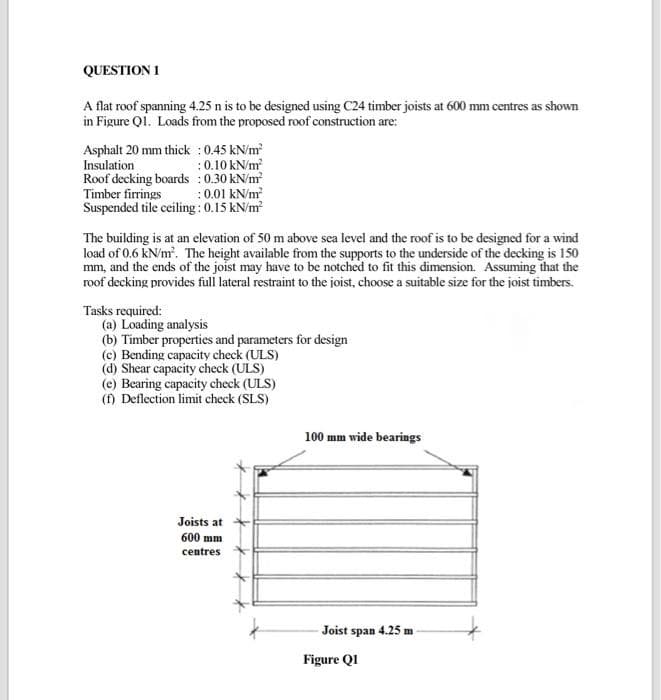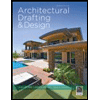QUESTION I A flat roof spanning 4.25 n is to be designed using C24 timber joists at 600 mm centres as shown in Figure Qi. Loads from the proposed roof construction are: Asphalt 20 mm thick : 0.45 kN/m Insulation Roof decking boards :0.30 kN/m Timber firrings Suspended tile ceiling: 0.15 kN/m :0.10 kN/m :0.01 kN/m The building is at an elevation of 50 m above sea level and the roof is to be designed for a wind load of 0.6 kN/m. The height available from the supports to the underside of the decking is 150 mm, and the ends of the joist may have to be notched to fit this dimension. Assuming that the roof decking provides full lateral restraint to the joist, choose a suitable size for the joist timbers. Tasks required: (a) Loading analysis (b) Timber properties and parameters for design (e) Bending capacity check (ULS) (d) Shear capacity check (ULS) (e) Bearing capacity check (ULS) () Deflection limit check (SLS) 100 mm wide bearings Joists at 600 mm centres Joist span 4.25 m
QUESTION I A flat roof spanning 4.25 n is to be designed using C24 timber joists at 600 mm centres as shown in Figure Qi. Loads from the proposed roof construction are: Asphalt 20 mm thick : 0.45 kN/m Insulation Roof decking boards :0.30 kN/m Timber firrings Suspended tile ceiling: 0.15 kN/m :0.10 kN/m :0.01 kN/m The building is at an elevation of 50 m above sea level and the roof is to be designed for a wind load of 0.6 kN/m. The height available from the supports to the underside of the decking is 150 mm, and the ends of the joist may have to be notched to fit this dimension. Assuming that the roof decking provides full lateral restraint to the joist, choose a suitable size for the joist timbers. Tasks required: (a) Loading analysis (b) Timber properties and parameters for design (e) Bending capacity check (ULS) (d) Shear capacity check (ULS) (e) Bearing capacity check (ULS) () Deflection limit check (SLS) 100 mm wide bearings Joists at 600 mm centres Joist span 4.25 m
Architectural Drafting and Design (MindTap Course List)
7th Edition
ISBN:9781285165738
Author:Alan Jefferis, David A. Madsen, David P. Madsen
Publisher:Alan Jefferis, David A. Madsen, David P. Madsen
Chapter29: Design Criteria For Structural Loading
Section: Chapter Questions
Problem 29.2Q
Related questions
Question
Please solve only (d) , (e) , and (f)

Transcribed Image Text:QUESTION 1
A flat roof spanning 4.25 n is to be designed using C24 timber joists at 600 mm centres as shown
in Figure Qi. Loads from the proposed roof construction are:
Asphalt 20 mm thick : 0.45 kN/m
Insulation
Roof decking boards : 0.30 kN/m
Timber firrings
Suspended tile ceiling : 0.15 kN/m?
:0.10 kN/m
:0.01 kN/m
The building is at an elevation of 50 m above sea level and the roof is to be designed for a wind
load of 0.6 kN/m. The height available from the supports to the underside of the decking is 150
mm, and the ends of the joist may have to be notched to fit this dimension. Assuming that the
roof decking provides full lateral restraint to the joist, choose a suitable size for the joist timbers.
Tasks required:
(a) Loading analysis
(b) Timber properties and parameters for design
(c) Bending capacity check (ULS)
(d) Shear capacity check (ULS)
(e) Bearing capacity check (ULS)
(f) Deflection limit check (SLS)
100 mm wide bearings
Joists at
600 mm
centres
Joist span 4.25 m
Figure QI
Expert Solution
This question has been solved!
Explore an expertly crafted, step-by-step solution for a thorough understanding of key concepts.
Step by step
Solved in 3 steps

Knowledge Booster
Learn more about
Need a deep-dive on the concept behind this application? Look no further. Learn more about this topic, civil-engineering and related others by exploring similar questions and additional content below.Recommended textbooks for you

Architectural Drafting and Design (MindTap Course…
Civil Engineering
ISBN:
9781285165738
Author:
Alan Jefferis, David A. Madsen, David P. Madsen
Publisher:
Cengage Learning

Architectural Drafting and Design (MindTap Course…
Civil Engineering
ISBN:
9781285165738
Author:
Alan Jefferis, David A. Madsen, David P. Madsen
Publisher:
Cengage Learning